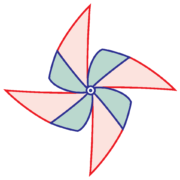FDA Approved Devices for Oxygen Delivery



One of the commonly used devices for delivering oxygen is a nasal cannula. The prongs deliver the oxygen directly into the nose. The oxygen can be delivered at a low flow or a high flow. Low flow oxygen can be delivered at a rate of 0.03 to 8 liters per minute. The cannula is small enough that some air is inhaled along with the oxygen. In other words, the patient is not breathing pure oxygen. In patients with lung disease who have low blood oxygen levels (oxygen saturation) in room air, the flow of oxygen is usually titrated to an amount that provides the patient with a normal oxygen saturation. In some patients with pulmonary hypertension, the amount of oxygen in the blood is already normal. Extra oxygen is given simply to help relax the blood vessels of the lung.
High flow oxygen is delivered with a nasal cannula that has large enough prongs that the delivery of oxygen can be much greater than the amount delivered with a low flow cannula. High flow oxygen can also be heated and humidified. The amount of oxygen entering the lung might approach 100% or pure oxygen. High flow oxygen is usually used in a hospital setting to deliver oxygen to critically ill patients that need high amounts of oxygen to sustain life. High flow oxygen is not usually needed to treat pulmonary hypertension alone.


A face mask can be used instead of a nasal cannula for some patients. Some face masks, nonrebreathing masks, are designed to increase the purity of oxygen compared to regular face masks. A face mask might be particularly helpful for patients that breath some through their mouth, not through their nose alone.
A CPAP mask or BiPAP mask is usually needed for patients who have sleep apnea or a lung problem that requires a continuous positive pressure to overcome airway obstruction or better expand the lungs. Some patients with sleep apnea have pulmonary hypertension and may also benefit from extra oxygen with the positive pressure. In patients with airway obstruction and sleep apnea, oxygen alone may help to treat the pulmonary hypertension. However, oxygen alone will not alleviate the airway obstruction and may not improve the quality of sleep or other complications associated with apnea.


An oxygen face tent fits under the patient’s chin and directs the flow of oxygen up over the mouth and nose. Blow by oxygen can be delivered with an oxygen face tent that is not positioned directly under the patient’s chin.


An oxygen hood is a chamber that is placed over the head of a patient, usually an infant, to enrich the amount of oxygen that the patient breathes. Blow by oxygen can be delivered with an oxygen hood.
An oxygen tent is a plastic or fabric tent that encloses the upper body or entire body of the patient to enrich the amount of oxygen that the patient breathes. Blow by oxygen can be delivered with an oxygen tent.
If your or your child’s health care provider has prescribed one of these devices and you use or your child uses the device well, there is no need to consider changing to blow by oxygen. Ideas for blow by oxygen are being developed primarily to help individuals with pulmonary hypertension who are not able to use a nasal cannula or face mask.
Additional Resources for Oxygen Therapy
American Lung Association (https://www.lung.org/lung-health-diseases/lung-procedures-and-tests/oxygen-therapy)
